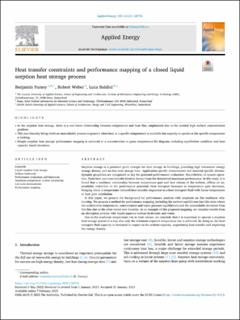Please use this identifier to cite or link to this item:
https://doi.org/10.21256/zhaw-27007Full metadata record
| DC Field | Value | Language |
|---|---|---|
| dc.contributor.author | Fumey, Benjamin | - |
| dc.contributor.author | Weber, Robert | - |
| dc.contributor.author | Baldini, Luca | - |
| dc.date.accessioned | 2023-02-16T14:39:50Z | - |
| dc.date.available | 2023-02-16T14:39:50Z | - |
| dc.date.issued | 2023-04-01 | - |
| dc.identifier.issn | 0306-2619 | de_CH |
| dc.identifier.uri | https://digitalcollection.zhaw.ch/handle/11475/27007 | - |
| dc.description.abstract | Sorption storage is a potential game changer for heat storage in buildings, providing high volumetric energy storage density and no loss over storage time. Application specific temperatures and material specific thermo-dynamic properties are recognized as key for potential performance evaluation. Nevertheless, in system operation, finite heat and mass transfer kinetics detract from the theoretical maximum performance. In this study, it is found that a nonlinear relationship between temperature gain and heat release of the sorbent, afflicts an unavoidable restriction to the performance potential. Heat transport increases as temperature gain decreases, bringing about a temperature induced heat transfer stagnation to a heat transport fluid with linear temperature to heat gain correlation. In this paper, we present the background for performance analysis with emphasis on this nonlinear relationship. We propose a method for performance mapping, including the sorbent equilibrium line (the state where the sorbent is in temperature, concentration and vapor pressure equilibrium) and the unavoidable deviation from this line due to the afore stated non-linearity. As an example of this proposed mapping, we visualize results from an absorption process with liquid aqueous sodium hydroxide and water. Due to the nonlinear temperature rise in heat release, we conclude that it is important to operate a sorption heat storage system in a way that only the minimum required temperature rise is achieved. By doing so, the heat transport fluid capacity is increased in respect to the sorbent capacity, augmenting heat transfer and improving the energy density. | de_CH |
| dc.language.iso | en | de_CH |
| dc.publisher | Elsevier | de_CH |
| dc.relation.ispartof | Applied Energy | de_CH |
| dc.rights | http://creativecommons.org/licenses/by/4.0/ | de_CH |
| dc.subject | Liquid sorption heat storage | de_CH |
| dc.subject | Sodium hydroxide | de_CH |
| dc.subject | Performance evaluation and limitation | de_CH |
| dc.subject | Nonlinear temperature to heat correlation | de_CH |
| dc.subject | Lab scale demonstrator | de_CH |
| dc.subject | Performance mapping | de_CH |
| dc.subject.ddc | 620: Ingenieurwesen | de_CH |
| dc.title | Heat transfer constraints and performance mapping of a closed liquid sorption heat storage process | de_CH |
| dc.type | Beitrag in wissenschaftlicher Zeitschrift | de_CH |
| dcterms.type | Text | de_CH |
| zhaw.departement | Architektur, Gestaltung und Bauingenieurwesen | de_CH |
| zhaw.organisationalunit | Institut Bautechnologie und Prozesse (IBP) | de_CH |
| dc.identifier.doi | 10.1016/j.apenergy.2023.120755 | de_CH |
| dc.identifier.doi | 10.21256/zhaw-27007 | - |
| zhaw.funding.eu | No | de_CH |
| zhaw.issue | 120755 | de_CH |
| zhaw.originated.zhaw | Yes | de_CH |
| zhaw.publication.status | publishedVersion | de_CH |
| zhaw.volume | 335 | de_CH |
| zhaw.publication.review | Peer review (Publikation) | de_CH |
| zhaw.author.additional | No | de_CH |
| zhaw.display.portrait | Yes | de_CH |
| Appears in collections: | Publikationen Architektur, Gestaltung und Bauingenieurwesen | |
Files in This Item:
| File | Description | Size | Format | |
|---|---|---|---|---|
| 2023_Fumey-etal_Closed-liquid-sorption-heat-storage-process.pdf | 1.69 MB | Adobe PDF |  View/Open |
Show simple item record
Fumey, B., Weber, R., & Baldini, L. (2023). Heat transfer constraints and performance mapping of a closed liquid sorption heat storage process. Applied Energy, 335(120755). https://doi.org/10.1016/j.apenergy.2023.120755
Fumey, B., Weber, R. and Baldini, L. (2023) ‘Heat transfer constraints and performance mapping of a closed liquid sorption heat storage process’, Applied Energy, 335(120755). Available at: https://doi.org/10.1016/j.apenergy.2023.120755.
B. Fumey, R. Weber, and L. Baldini, “Heat transfer constraints and performance mapping of a closed liquid sorption heat storage process,” Applied Energy, vol. 335, no. 120755, Apr. 2023, doi: 10.1016/j.apenergy.2023.120755.
FUMEY, Benjamin, Robert WEBER und Luca BALDINI, 2023. Heat transfer constraints and performance mapping of a closed liquid sorption heat storage process. Applied Energy. 1 April 2023. Bd. 335, Nr. 120755. DOI 10.1016/j.apenergy.2023.120755
Fumey, Benjamin, Robert Weber, and Luca Baldini. 2023. “Heat Transfer Constraints and Performance Mapping of a Closed Liquid Sorption Heat Storage Process.” Applied Energy 335 (120755). https://doi.org/10.1016/j.apenergy.2023.120755.
Fumey, Benjamin, et al. “Heat Transfer Constraints and Performance Mapping of a Closed Liquid Sorption Heat Storage Process.” Applied Energy, vol. 335, no. 120755, Apr. 2023, https://doi.org/10.1016/j.apenergy.2023.120755.
Items in DSpace are protected by copyright, with all rights reserved, unless otherwise indicated.